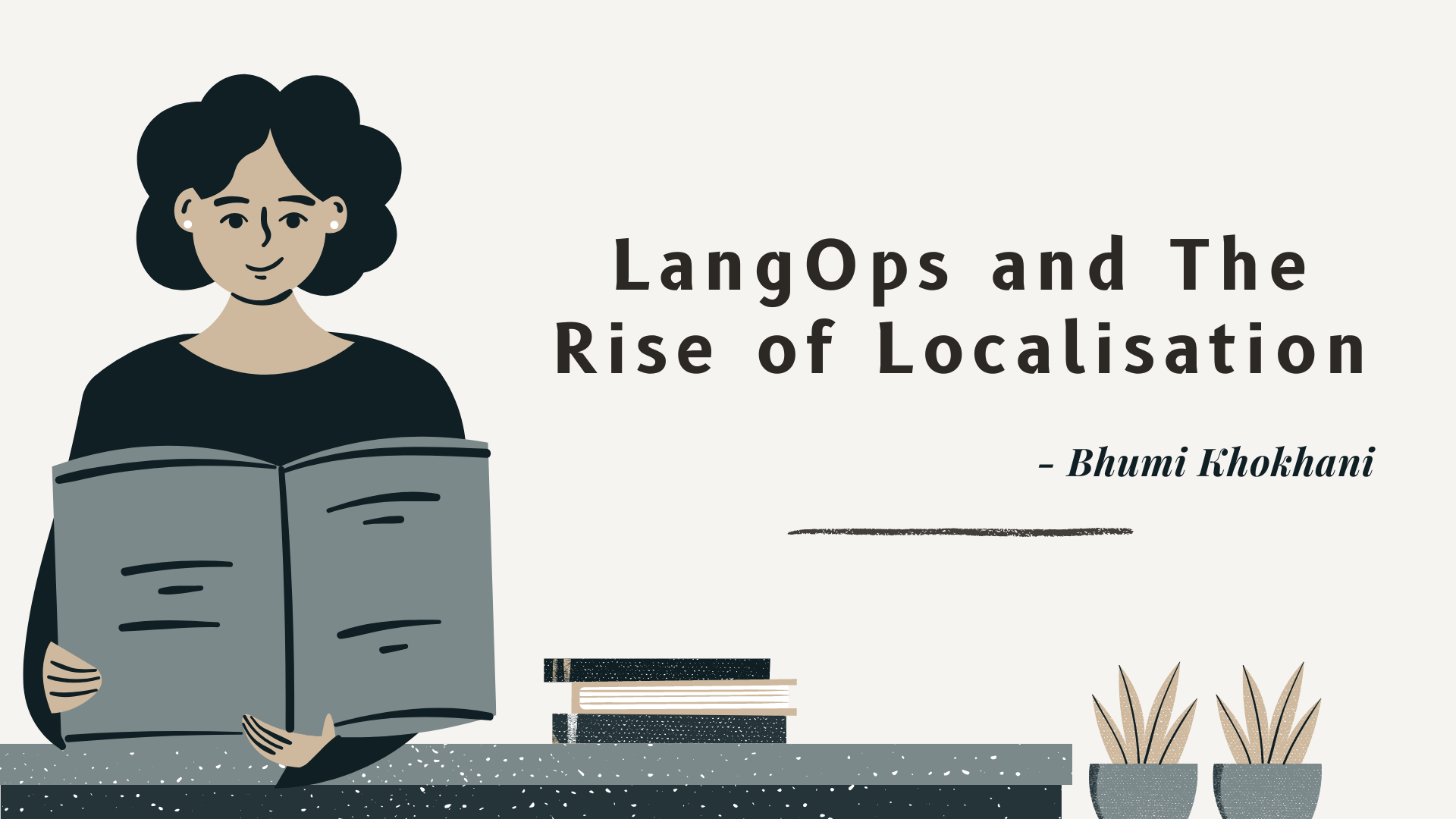LangOps and The Rise of Localisation
 Bhumi Khokhani
Bhumi Khokhani
The link to the original post is here
Introduction
As the world gets more globalized, language becomes increasingly important for many organizations in order to engage with customers all over the world. In fact, over half of marketers (49 percent) responded that localized marketing is absolutely crucial to their business success in a CMO Council poll. Existing language projects are distributed, and most businesses lack organized resources to maximize multilingualism.
Because of significant advances in the field of artificial intelligence, there is now a method to alleviate such problems by centralizing resources to streamline language translation throughout the whole enterprise. It's referred to as Language Operations (LangOps).
Let's get deeper into why language is so important for customer support, the advantages, and how to select a LangOps leader to focus on growing technology and teams as required.
We will also go about an amazing open-source tool, that will assist you through which sounds perfect for your project.

What are LangOps and Localization?
To be relevant in the global world, you must be able to communicate effectively with your audiences. While localization will be important to the success of your firm if you plan to take it global.
Language operations, often known as LangOps, on the other hand, is the new paradigm we require. While localization is concerned with how to translate and regionalize computer programs and web pages, language operations are concerned with how to make this procedure more efficient.
LangOps teams must be cross-functional and interdisciplinary in nature. Cutting-edge, adaptive software that is accessible to users with diverse degrees of technical skill should be used to allow LangOps technologically.
This is the only method to operationalize language effectively and at scale.
Technologically,LangOps should be aided by cutting-edge, adaptable software that is accessible to persons with varying levels of technical expertise.
This is the only method to operationalize language effectively and at scale.
Why LangOps?
The idea is to make a product or service appear to be tailored to the specific needs of the target market. To cater to the new audience, the company must incorporate cultural awareness into everything from location, style, layout, and content, and even rethink the product itself.
LangOps is less fragmented
Localization efforts are often led by a single department within a corporation. Marketing, for instance, is in charge of localizing a website or a digital campaign for various audiences. There haven't been any effective approaches to operationalizing language throughout the company until now.
A chief operating officer or a specialized LangOps executive, on the other hand, would oversee all language-related initiatives under a LangOps strategy.
They'd concentrate on how the company as a whole can enter a new market. They'd concentrate on how the entire firm can enter a new market, from sales to marketing to customer service and beyond. They'd also go with multilingual machine translation technology, which can enable anyone to speak in several languages, but more on that in a moment.
LangOps enables businesses to expand
The majority of current localization initiatives are focused on fragmentary translation and regional integration of websites, software, and other items. This strategy frequently relies on outsourcing and is difficult to scale when the company expands into new regions.
Furthermore, maintaining translation quality may be a tough and time-consuming task that is typically delegated to a limited group of department-specific developers.
The advent of operations-for-everything has demonstrated how technology (especially artificial intelligence) may help teams grow much beyond their own workforce or capacity to employ external experts.
Other departments' operations methods have used technology to make cross-departmental collaboration more effective and scalable, such as marketing operations, revenue operations, and possibly the most popular, DevOps.
LangOps is a more comprehensive
Language must be viewed as a company-wide requirement, yet one-off localization efforts may not serve this aim.
Only 28% of respondents say they can obtain customer service in their native language, according to recent Intercom research. Surprisingly, 70% of individuals stated they would be more loyal to brands that offered native language help, and 35% said they would switch products entirely.
Given the native language's genuine revenue-driving and brand-building potential, enterprises must begin to think about it more holistically (which echoes the point about siloes above). A LangOps approach would focus on how to do business in a local market while also considering the team's cross-departmental demands.

Why Switch to LangOps?
This is what leaders from multinational corporations had to say about LangOps.
LangOps is cost-effective
A coordinated LangOps platform, according to more than 90% of those polled, is an inexpensive way to accomplish more with less.
LangOps centralized is beneficial
Over 86 percent of respondents say that having a centralized LangOps team in charge of all translation and localization operations in their company would add value.
LangOps critical for global market strategy
Since over 90% of employees surveyed, for global market strategy, LangOps is said to be highly or extremely critical for their company.
Optimistic market for quick adoption
While 52% are so enthused about LangOps, in the next five to 6 months, they look forward to installing LangOps.
LangOps Strategy
LangOps talent or development of a LangOps unit being hired can help international corporations engage with their customers as well as stakeholders in their native language more successfully.
Traditional translation methods can be broken down by a specialized language team, which can encourage the use of language as a corporate asset.
And it’s important to understand that upcoming machine translations in the translation industry won’t steal the jobs of people, instead, companies will seek linguistic skills, ensuring the quality of machine translations and building efficient language practices across the organization.

How to choose a LangOps leader?
Hiring a LangOps leader to create and drive an AI-powered language strategy is a requirement if your company actually wants to speak the same language as its consumers.
A LangOps leader's main tasks include:
- Purchasing and deploying machine translation systems.
- Using company-specific language to train machine learning models.
- The success of enhanced translation skills is measured.
- In the day-to-day operations, training agents to use the technology.
Due to the frequent recruiting of the role necessitating advice from the company’s head of localization, the LangOps leader must be linguistically versatile and also be able to grasp semantics in varied situations.
Therefore, for frequent hiring for such roles, chief operational officers, customer service executives, and translation specialists are required to collaborate.
Traits to look for in a LangOps leader are:
- Participation in the day-to-day operations of a tech-driven language services provider.
- Understanding of how to create and manage a language translation budget.
- Capability to employ language annotation and machine learning techniques.
- To develop solid connections with stakeholders, it’s important to have excellent communication skills as well as a skillful track record in development.
- One of the most effective strategies to speed worldwide expansion is to support multilingual customer service.
Tolgee

If you want to achieve good results, you need to use a good localization tool. Tolgee allows a more efficient and clear localization process for developers, product managers, and translators. Now is the time to visit their website and learn how simple and successful localization can be with the right tool and workflow.
Tolgee is the only tool you'll ever need to translate a web-based project into any language.
Open-source, with a simple workflow that takes less than a minute to deploy. Just 3 easy steps:
- Create your app
- Work with Tolgee
- Delegate translation responsibilities to translators.
It is that simple!
Closing
So, if you want to expand your business globally, including localization in your plan will help you overcome cultural obstacles and enter new markets easily. While, understanding the value of localization is only the first step, choosing the best technology to optimize your efforts while convincing your company’s stakeholders is the next.
For long-term and difficult projects, I choose Tolgee since it has the most solid feature sets, broad integration, and file format support. In addition, Tolgee offers an easy-to-use UI.
Let me know if you have any queries in the comments section.
And would you be interested in using an open-source tool like Tolgee? Do let me know in the comment section below. I hope you enjoyed reading it!
Feel free to connect with me on LinkedIn | Twitter
If you like my work, you can extend your support by buying me a ☕. Thank you!
Subscribe to my newsletter
Read articles from Bhumi Khokhani directly inside your inbox. Subscribe to the newsletter, and don't miss out.
Written by

Bhumi Khokhani
Bhumi Khokhani
I am a writer, web developer, application developer, graphic designer and also a Blender3D artist.
